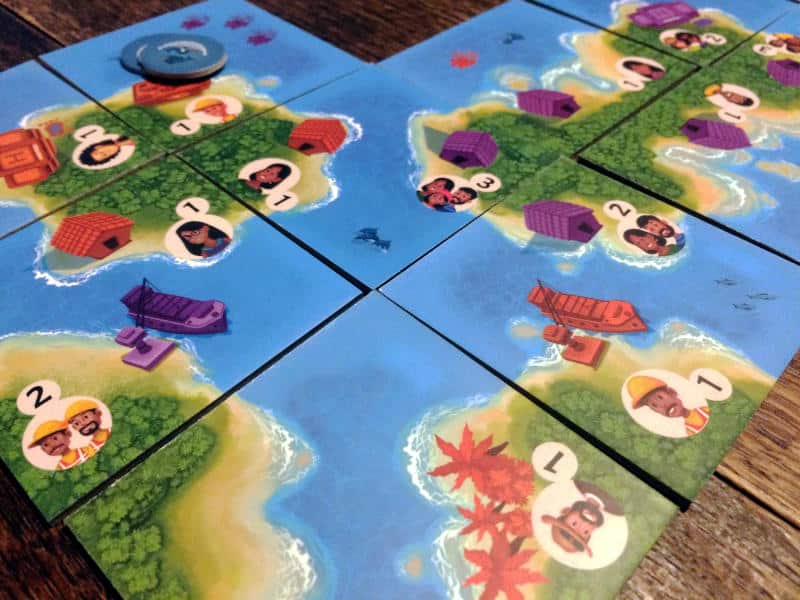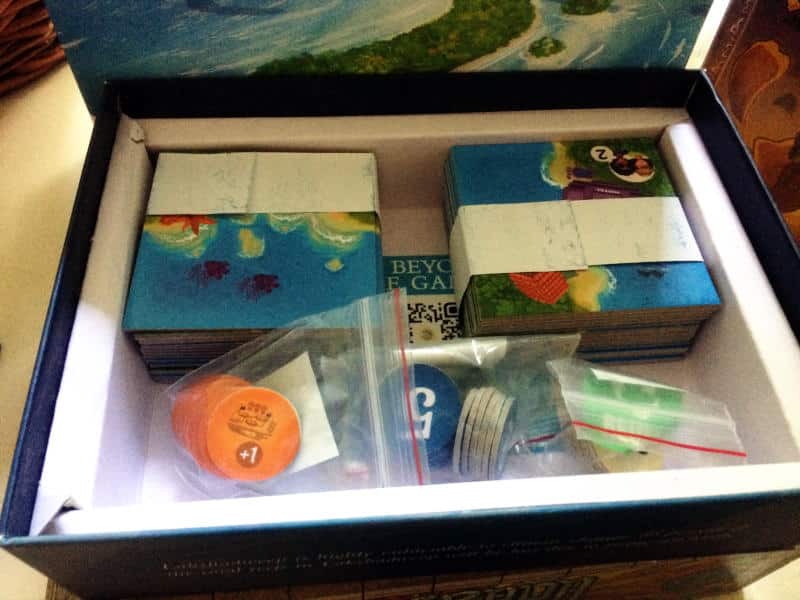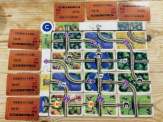| Release Date: 2023 | Players: 2 (only) |
| Designer: Sidhant Chand | Length: 30-45 minutes |
| Artist: Mazhar Kothari | Age: 10+ |
| Publisher: Luma World | Complexity: 1.5 / 5 |
| Plastic (by weight): <1% | Air (by volume): 10% |
Of the over 30 atolls and coral reefs in the Laccadive Sea, off the coast of Kerala, India, only 10 are inhabited. Of those, only a few are open to tourists. To visit the islands you need permission from the nearest customs office in Kochi, which is over 300 miles away. It helps strike the right balance between creating a good income stream for the islands, while also supporting sustainable tourism and preserving the fragile ecosystem of Lakshadweep by Sidhant Chand from Luma World.
As you can tell from the introduction, the game’s setting was chosen intentionally. The game tries to teach players more about the impact of tourism on important ecosystems like that found throughout the collection of islands that makes up Lakshadweep. At the same time, it doesn’t position itself squarely as an educational game. There is no long introduction in the rulebook that warns players of the threat of tourism. There are no pictures of wildlife in peril.
Instead, there is a single sentence that sets the scene: “create a thriving, sustainable and efficient island society where nature and humanity coexist!” It’s only through the rules that players are gently nudged down a specific route to sustainability. You want to score the most points, but you can do this only when you ensure there is enough room for everyone, humans and nature alike. So let me explain how this works.

Get yourself a wooden Tabletop Games Blog dice tray.
Each tray is the perfect size to roll your dice, and with the soft mat, it’s really quiet, while the wooden frame makes it wonderfully sturdy.
Tile-Laying for Two
Lakshadweep is very much a classic tile-laying game. It feels very similar to Carcassonne, but instead of building cities and roads, you build a collection of islands. That’s where the similarities end though.
First of all, the game is for two players only – no more, no less. That player limit could restrict its appeal, but as a game that’s very quick to learn and rather quick to play, it also makes it perfect for couples. I have played this game many times with my wife while on holiday (no, not in Lakshadweep) and we very much enjoyed it. The game doesn’t really give players much opportunity to be nasty to each other. In fact, every tile you place will always give both players some points. It’s more about working out how to place the tile so that it gives you more points.

Another difference is that you don’t draw tiles from a single face-down stack. Instead, everything is always face-up and there are always three tiles available – one on top of the draw deck, plus two to the side. Additionally, all tiles are double-sided and every tile has a combination of features on it. There are hotels, houses, ports, fisheries, forests and corals. Each feature is one of two colours, representing the two players. So there might be an orange hotel and a purple forest for example. The reverse of this tile contains the same features, but the colours are reversed. So the rear of the example would show a purple hotel and an orange forest. So as you choose tiles, you can flip them over to give you more points, that is unless you chose the tile from the top of the draw deck.
Learning by Playing
Of course, as you would expect from a tile-laying game, there are certain placement rules to consider. Tiles have to be attached along the edges with at least one other tile. Features must also match, so water has to go with water, land with land.
Additionally, there are certain restrictions, which is where the educational part comes in. For example, there can only be one hotel on each island and if fisheries are too close together, you won’t score much for them. So as you think about tile placement, you actually think about sustainability. You learn without even noticing. It can sometimes really be quite tricky to find another good spot for a fishery.
When the game is over and you look at the atoll you created together, you can see how certain features are clumped together, because that scores more points, while others are spread out for the same reason. It’s the scoring, as set by the rules, that makes Lakshadweep an educational game. After every game, I was surprised how we got higher scores than before, because we were better at creating a more sustainable collection of islands.
Even the game itself, as a product, is trying to be sustainable. Apart from a few small plastic ziplock bags, there are no plastic components. The tiles are held together by a paper belly band. There is no shrinkwrap around the box, but instead, there are two small pieces of tape to keep the box shut. There is also very little air in the box, meaning more units can be shipped together. It all adds up to a really wonderful product and shows that games can be greener.

Visit Lakshadweep
There isn’t really much more I can add to my review without talking about the rules in more detail. All I can say is that Lakshadweep is a really fun little two-player tile-laying game that is easy to learn and plays in less than an hour. It’s a title that I’ll keep in my collection. It will come out regularly for date night with my wife. So, Lakshadweep, here we come – metaphorically speaking anyway.
If you enjoyed this article, please have a look at my support page to see how you can help keep the blog going.
Useful Links
- Lakshadweep: https://lumaworld.
in/ collections/ educational-toys-for-kids/ products/ lakshadweep - Rulebook: https://boardgamegeek.
com/ filepage/ 256506/ lakshadweep-rulebook - Luma World: https://lumaworld.
in/ - BGG listing: https://boardgamegeek.
com/ boardgame/ 373877/ lakshadweep
Videos
Transparency Facts
I feel that this review reflects my own, independent and honest opinion, but the facts below allow you to decide whether you think that I was influenced in any way. Please also read my Ethics Statement for more information.- I was given a free review copy of this game by the publisher.
- At the time of writing, I have not received financial support from the publisher or anyone working on their behalf.
Audio Version
Intro Music: Bomber (Sting) by Riot (https://www.
The following music was used for this media project:
Music: Australia by MusicParadise
Free download: https://filmmusic.io/song/5056-australia
License (CC BY 4.0): https://filmmusic.io/standard-license
Artist website: http://www.music-paradise.de





